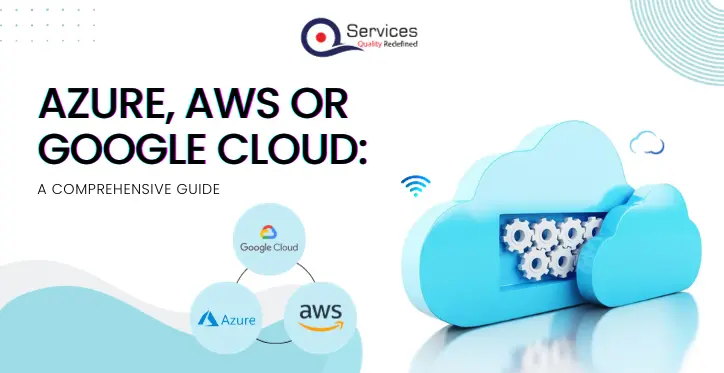Home » Azure, AWS, Google Cloud: Choosing the Ideal Cloud Partner For Your Business

In the rapidly growing digital environment, businesses are quickly shifting their operations online. This digital revolution is being driven in large part by the rising acceptance of cloud computing, which is becoming essential to modern business practices. As organizations carefully navigate this environment, choosing the correct cloud provider becomes critical, impacting long-term value.
This comparison looks at Google Cloud, Microsoft Azure, and Amazon Web Services (AWS), three major cloud computing platforms that compete to offer unmatched services. Making decisions requires a thorough understanding of each platform’s unique characteristics and effectiveness in connection to the functional and business goals of the organization.
The objective of this research is to describe the distinctive features that set Azure, Google Cloud, and AWS apart. By the end, organizations should be able to identify which platform best suits their needs, which will eventually enable them to make the best choices in the rapidly evolving field of cloud computing.
Cloud computing operates as a virtual space on the internet, providing a cloud computing solution for businesses to store, access, and manage data and programs. Instead of relying solely on your computer’s hard drive or local servers, cloud computing allows you to tap into a network of remote servers hosted on the internet to perform a variety of tasks.
It offers a diverse range of services, enabling the execution of applications, facilitating data analysis, content delivery, and much more, all without the constraints of physical hardware management. Multiple users, regardless of their location, can seamlessly access and collaborate on the same data or project, enhancing flexibility and efficiency.
Get free Consultation and let us know your project idea to turn into an amazing digital product.
Making the transition to the cloud requires thoughtful decisions, and familiarity with deployment techniques is essential. We will examine the subtle differences between various cloud deployment approaches together so you can make wise choices.
The public cloud is a virtual space accessible to a broad audience, offering a platform to host websites and web applications. It is cost-effective, scalable, and suitable for applications with a global user base.
A private cloud provides dedicated infrastructure for a single organization, ensuring enhanced security and control. Ideal for safeguarding sensitive data, offering a heightened level of customization and control.
Combining the strengths of both public and private clouds, the hybrid cloud caters to diverse organizational needs. It offers flexibility, scalability, and customization, allowing businesses to balance security and accessibility.
Organizations are making the shift to cloud computing often struggle with issues related to pricing, security, and the overall advantages of this transformative technology. Let’s break down these advantages in a way that’s easy to grasp.
Cloud computing operates on a pay-as-you-go model, ensuring you pay only for what you use, resulting in lower costs and higher returns.
Cloud hosts dedicate themselves to round-the-clock security monitoring, employing encryption for robust protection. A study found that 94% of businesses experienced improved security with cloud adoption.
Cloud services offer unmatched flexibility, allowing organizations to scale resources instantly to meet business demands.
Access to corporate data via cloud computing ensures global connectivity, benefiting remote employees and fostering work-life balance.
Cloud platforms enhance collaboration, making information easily accessible and shareable, ultimately boosting teamwork.
Cloud-based systems ensure consistency in data storage, avoiding errors and providing clear records of revisions.
Cloud services offer quick data recovery for various emergency scenarios, reducing downtime and minimizing potential losses.
Cloud applications automate updates, saving time and reducing reliance on internal IT resources.
Early adoption of cloud technology gives organizations a competitive advantage, fostering faster revenue growth.
IaaS is the provision of virtualized computing resources, presenting users with the foundational components of a data center. It offers a scalable environment where virtual machines, storage, and networks can be configured and managed according to specific requirements. IaaS empowers businesses with granular control over their infrastructure without the burdens of physical upkeep.
Applications: It is particularly suitable for enterprises seeking a flexible and scalable infrastructure solution, IaaS provides a comprehensive platform for businesses with diverse computing needs.
PaaS represents a managed platform that furnishes developers with a ready-to-use environment for building, testing, and deploying applications. In this model, the underlying infrastructure complexities are abstracted, allowing developers to concentrate solely on the development process. PaaS streamlines the application lifecycle, offering an efficient solution for rapid development and deployment.
Applications: Tailored for development teams aiming to expedite the application development cycle, PaaS is ideal for scenarios where swift deployment and reduced infrastructure management are important.
SaaS delivers fully functional software applications over the internet, providing users with on-demand access to software without the need for local installations or maintenance. It embodies a subscription-based model, offering businesses ready-to-use applications hosted and managed by the service provider.
Applications: SaaS is the optimal for businesses seeking efficient, off-the-shelf solutions for tasks such as email, document management, and customer relationship management. It is widely embraced for its convenience.
AWS has been the powerhouse of cloud services, particularly known for its AWS compute services. As the unrivalled leader in the public cloud domain, AWS stands out for its reliability, scalability, and budget-friendly options. With an impressive lineup including EC2, Lambada, Lightsail, Aurora, DynamoDB, and S3, AWS remains the top choice for developers, data scientists, and solution architects.
Microsoft Azure, an established provider of Azure cloud services, entered the market in 2010 and adds intelligence to the cloud environment. What is Azure? For organizations looking to build secure and forward-thinking solutions, Azure offers a versatile range of options, including on-premises, hybrid, multi-cloud, and edge computing. Azure’s notable services like OpenAI, DevOps, Virtual Machines, and Machine Learning Services make it the go-to for businesses keen on innovation and adaptability.
Google Cloud is synonymous with cutting-edge cloud capabilities, making app development a breeze, decisions more informed, and collaboration seamless. Widely adopted in telecommunications, media, retail, and software sectors, Google Cloud boasts over 150 innovative products covering computing, storage, AI, database, analytics, and networking.
The three main providers of cloud computing are Amazon Web Services (AWS), Microsoft Azure, and Google Cloud Platform (GCP), each of which provides a distinct range of services. Now let’s explore the differences, showing how these massive cloud providers meet various business needs.
Strengths:
Weaknesses:
Strengths:
Weaknesses:
Strengths:
Weaknesses:
Strengths:
Weaknesses:
Strengths:
Azure offers about 90 services, integrating seamlessly with Windows-based systems.
Compute Services: Focuses on virtual machines, cloud services, and resource managers with strong networking capabilities.
Tools: Azure DevOps fosters collaboration and streamlines development.
Weaknesses:
Service Spectrum: Some of Microsoft Azure cloud services are still growing up compared to those of AWS.
Regional Availability: Azure services may have limited regional availability compared to AWS.
Strengths:
Weaknesses:
Strengths:
Weaknesses:
Strengths:
Weaknesses:
Strengths:
Weaknesses:
Options:
Amazon EKS Anywhere, AWS Outposts, and VMware Cloud on AWS for hybrid scenarios
Various tools provide flexibility in multi-cloud environments.
Options:
Azure Arc, Azure Stack, and Azure Backup for enhanced flexibility in hybrid and multi-cloud settings.
Diverse tools cater to hybrid and multi-cloud needs.
Options:
Anthos, Looker, and Cloud Run for Anthos to enhance operational efficiency in hybrid and multi-cloud environments.
Tools:
A range of operational tools such as AWS Snowball, AWS Wavelength, and AWS Local Zones
Operational efficiency is supported by diverse tools.
b. Microsoft Azure:
Tools:
Azure Backup, Azure Security Center, and Azure Centinel for robust operational capabilities.
Tools:
Leverages Anthos, Looker, and Cloud Run for Anthos to enhance operational efficiency.
Competitive pricing aims to undercut competitors, making it appealing for small businesses.
Navigating the intricacies of AWS, Azure, and GCP involves a meticulous consideration of several factors:
Workload Analysis: Assess the nature of your workloads, discerning the demands for computing power, integration, or advanced analytics.
Budgetary Alignment: Evaluate budget constraints and how each platform’s pricing aligns with your financial considerations.
Scalability Requirements: Determine scalability needs, accounting for future growth and flexibility in resource scaling.
Technical Proficiency: Consider your team’s technical expertise and comfort level with the tools and services offered by each platform.
Industry Tailoring: Account for industry-specific requirements and regulations, as certain platforms may offer tailored solutions for specific sectors.
Although Amazon Web Services (AWS) undoubtedly holds the lead in the cloud computing industry, Microsoft Azure is rapidly developing into a more potent and intelligent competitor. AWS leads the industry significantly, but Azure is making a name for itself, especially when it comes to meeting the complex demands of businesses.
Azure is an excellent choice for businesses that rely significantly on Microsoft technology since it shows strategic intelligence in satisfying the needs of large-scale enterprises. Azure is marketed as an innovative approach that seamlessly integrates with Windows-based systems and encourages teamwork due to its advanced Azure DevOps platform.
Meanwhile, Google Cloud is making significant strides in the dynamic cloud computing landscape, forging partnerships with diverse businesses and championing open-source initiatives. However, Azure stands out amongst its counterparts, transcending the role of a mere platform by comprehensively understanding and addressing the distinctive demands of enterprise-level entities.
As enterprises undergo transformation, Azure evolves beyond being a practical choice to become a strategic imperative. It transforms into a collaborative partner adept at navigating the intricacies of contemporary business requirements, surpassing the realm of a mere technical solution.
In addition, Google Cloud is setting the standard in the dynamic cloud computing platform through partnerships with diverse businesses and the encouragement of open-source initiatives. Despite this, Azure is distinct from its competitors since it is a platform that understands and caters to the unique demands of enterprise-level businesses. As businesses evolve, Azure becomes a partner able to skillfully manage the complexities of today’s business requirements, rather than simply a technical solution.

Content writer
INDIA : F-190, Phase 8B, Industrial Area, Sector 74,
Mohali, India
CANADA : 55 Village Center Place, Suite 307 Bldg 4287, Mississauga ON L4Z 1V9, Canada
USA :2598 E Sunrise Blvd, Fort Lauderdale,FL 33304,
United States

Founder and CEO

Chief Sales Officer
